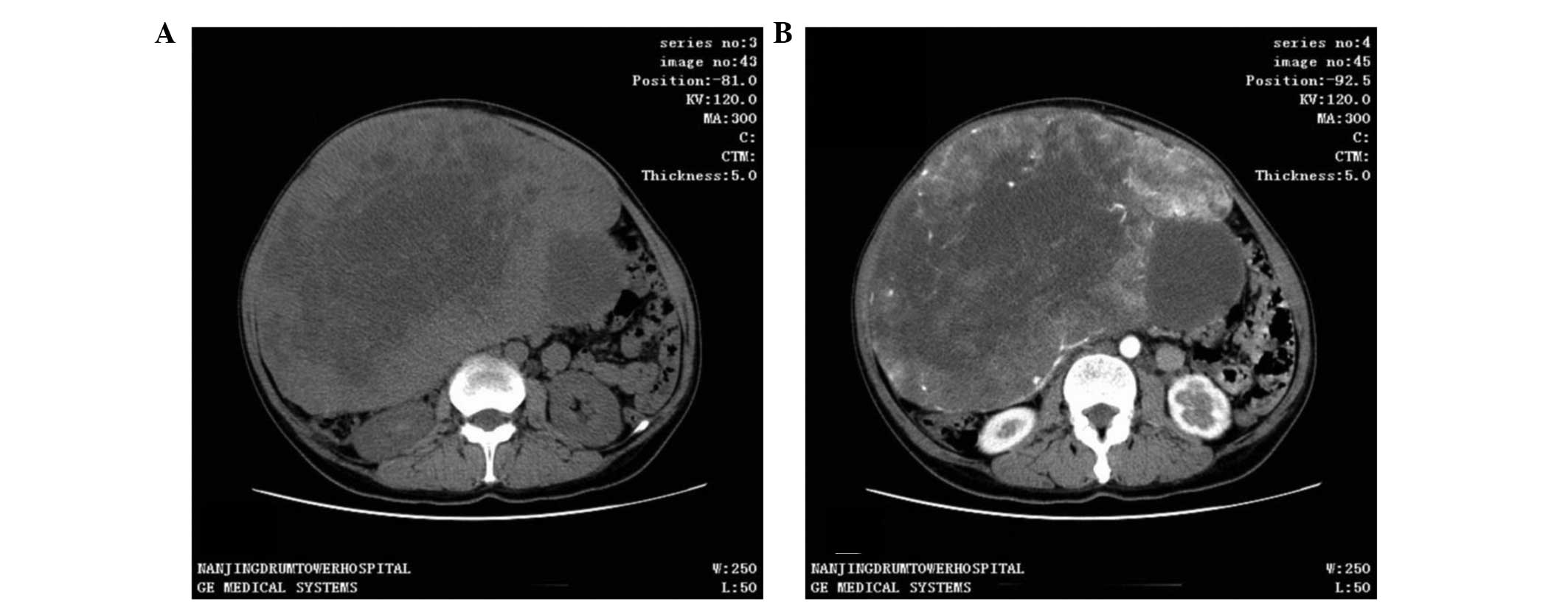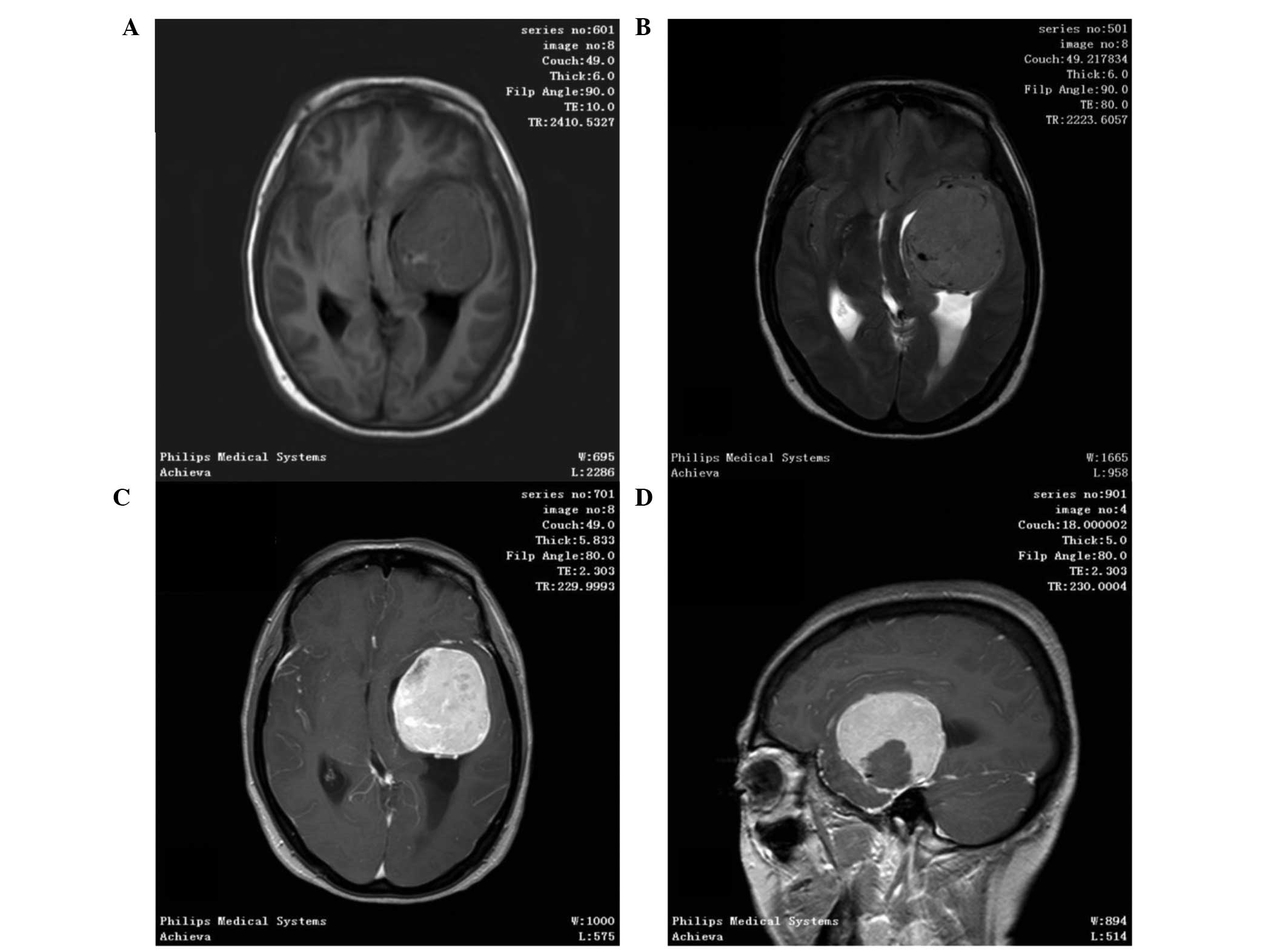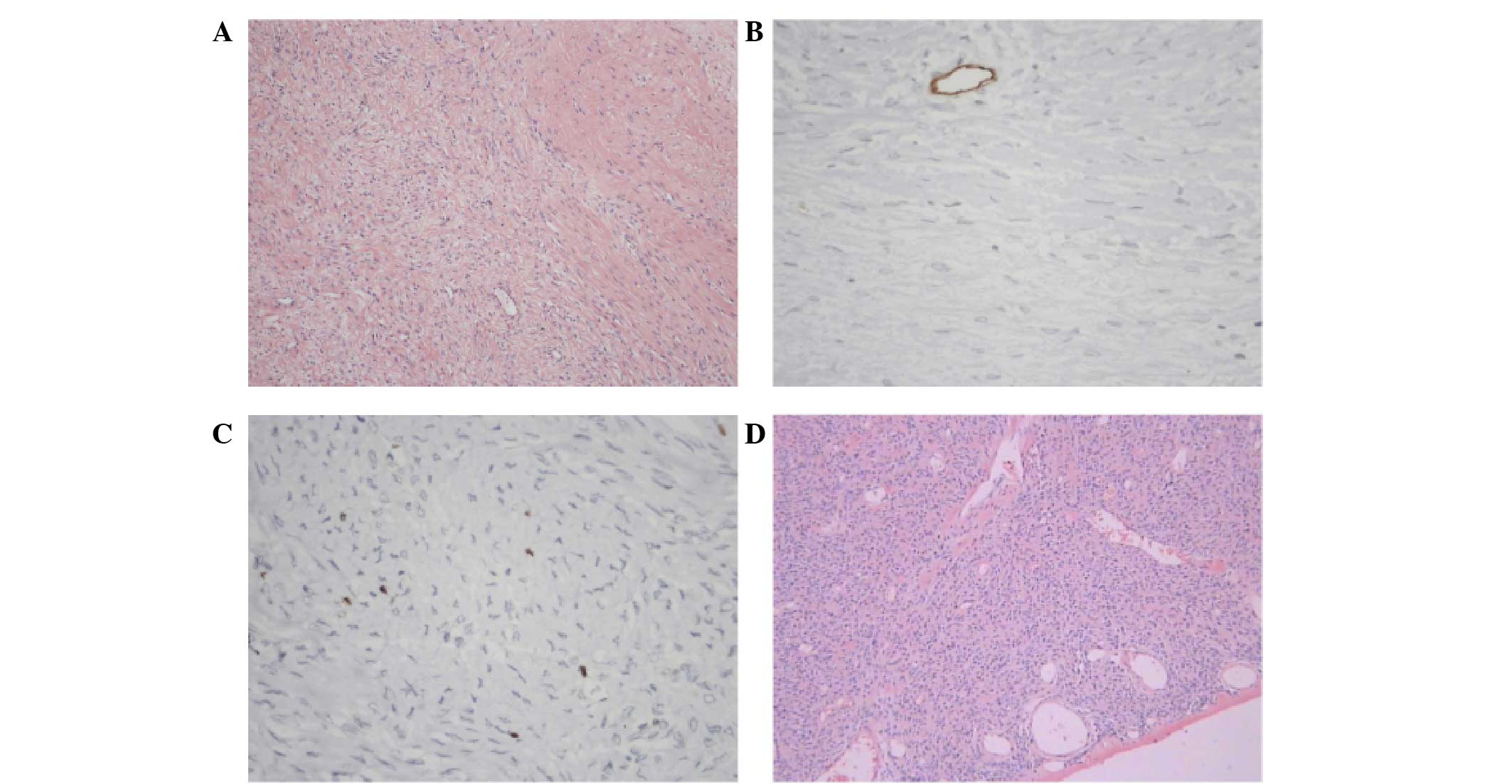|
1
|
Klemperer P and Coleman BR: Primary
neoplasms of the pleura. A report of five cases. Am J Ind Med.
22:1–31. 1992. View Article : Google Scholar : PubMed/NCBI
|
|
2
|
Gold JS, Antonescu CR, Hajdu C, Ferrone
CR, Hussain M, Lewis JJ, Brennan MF and Coit DG: Clinicopathologic
correlates of solitary fibrous tumors. Cancer. 94:1057–1068. 2002.
View Article : Google Scholar : PubMed/NCBI
|
|
3
|
vanHoudt WJ, Westerveld CM, Vrijenhoek JE,
van Gorp J, van Coevorden F, Verhoef C and van Dalen T: Prognosis
of solitary fibrous tumors: A multicenter study. Ann Surg Oncol.
20:4090–4095. 2013. View Article : Google Scholar : PubMed/NCBI
|
|
4
|
England DM, Hochholzer L and McCarthy MJ:
Localized benign and malignant fibrous tumors of the pleura. A
clinicopathologic review of 223 cases. Am J Surg Pathol.
13:640–658. 1989. View Article : Google Scholar : PubMed/NCBI
|
|
5
|
Ogawa K, Tada T, Takahashi S, Sugiyama N,
Inaguma S, Takahashi SS and Shirai T: Malignant solitary fibrous
tumor of the meninges. Virchows Arch. 444:459–464. 2004. View Article : Google Scholar : PubMed/NCBI
|
|
6
|
Saceda-Gutiérrez JM, Isla-Guerrero AJ,
Pérez-López C, Ortega-Martínez R, de la Riva A Gómez,
Gandia-González ML, Gutiérrez-Molina M and Rey-Herranz JA: Solitary
fibrous tumors of the meninges: Report of three cases and
literature review. Neurocirugia (Astur). 18:496–504. 2007.(In
Spanish). View Article : Google Scholar : PubMed/NCBI
|
|
7
|
Adeleye AO, Ogun OA and Ogun GO: Orbital
solitary fibrous tumor. Another rare case from Africa. Int
Ophthalmol. 30:315–318. 2010. View Article : Google Scholar : PubMed/NCBI
|
|
8
|
Kessler A, Lapinsky J, Berenholz L,
Sarfaty S and Segal S: Solitary fibrous tumor of the nasal cavity.
Otolaryngol Head Neck Surg. 121:826–828. 1999. View Article : Google Scholar : PubMed/NCBI
|
|
9
|
O'Regan EM, Vanguri V, Allen CM, Eversole
LR, Wright JM and Woo SB: Solitary fibrous tumor of the oral
cavity: Clinicopathologic and immunohistochemical study of 21
cases. Head Neck Pathol. 3:106–115. 2009. View Article : Google Scholar : PubMed/NCBI
|
|
10
|
Jeong AK, Lee HK, Kim SY and Cho KJ:
Solitary fibrous tumor of the parapharyngeal space: MR imaging
findings. AJNR Am J Neuroradiol. 23:473–475. 2002.PubMed/NCBI
|
|
11
|
Kim TA, Brunberg JA, Pearson JP and Ross
DA: Solitary fibrous tumor of the paranasal sinuses: CT and MR
appearance. AJNR Am J Neuroradiol. 17:1767–1772. 1996.PubMed/NCBI
|
|
12
|
Cho KJ, Ro JY, Choi J, Choi SH, Nam SY and
Kim SY: Mesenchymal neoplasms of the major salivary glands:
Clinicopathological features of 18 cases. Eur Arch
Otorhinolaryngol. 265(Suppl 1): S47–S56. 2008. View Article : Google Scholar : PubMed/NCBI
|
|
13
|
Mathew GA, Ashish G, Tyagi AK,
Chandrashekharan R and Paul RR: Solitary Fibrous Tumor of Nasal
Cavity: A Case Report. Iran J Otorhinolaryngol. 27:307–312.
2015.PubMed/NCBI
|
|
14
|
Huang SC, Li CF, Kao YC, Chuang IC, Tai
HC, Tsai JW, Yu SC, Huang HY, Lan J, Yen SL, et al: The
clinicopathological significance of NAB2-STAT6 gene fusions in 52
cases of intrathoracic solitary fibrous tumors. Cancer Med.
5:159–168. 2016. View
Article : Google Scholar : PubMed/NCBI
|
|
15
|
Chis O and Albu S: Giant solitary fibrous
tumor of the parotid gland. Case Rep Med.
2014:9507122014.PubMed/NCBI
|
|
16
|
Li XM, Reng J, Zhou P, Cao Y, Cheng ZZ,
Xiao Y and Xu GH: Solitary fibrous tumors in abdomen and pelvis:
Imaging characteristics and radiologic-pathologic correlation.
World J Gastroenterol. 20:5066–5073. 2014. View Article : Google Scholar : PubMed/NCBI
|
|
17
|
Park SB, Park YS, Kim JK, Kim MH, Oh YT,
Kim KA and Cho KS: Solitary fibrous tumor of the genitourinary
tract. AJR Am J Roentgenol. 196:W132–W137. 2011. View Article : Google Scholar : PubMed/NCBI
|
|
18
|
Bauer JL, Miklos AZ and Thompson LD:
Parotid gland solitary fibrous tumor: A case report and
clinicopathologic review of 22 cases from the literature. Head Neck
Pathol. 6:21–31. 2012. View Article : Google Scholar : PubMed/NCBI
|
|
19
|
Messa-Botero OA, Romero-Rojas AE, Olaya SI
Chinchilla, Díaz-Pérez JA and Tapias-Vargas LF: Primary malignant
solitary fibrous tumor/hemangiopericytoma of the parotid gland.
Acta Otorrinolaringol Esp. 62:242–245. 2011.(In Spanish).
View Article : Google Scholar : PubMed/NCBI
|
|
20
|
Hunt I, Ewanowich C, Reid A, Stewart K,
Bédard EL and Valji A: Managing a solitary fibrous tumour of the
diaphragm from above and below. ANZ J Surg. 80:370–371. 2010.
View Article : Google Scholar : PubMed/NCBI
|
|
21
|
Kita Y: Pleural solitary fibrous tumor
from diaphragm, being suspected of liver invasion; report of a
case. Kyobu Geka. 65:338–340. 2012.(In Japanese). PubMed/NCBI
|
|
22
|
Wang H, Chen P, Zhao W, Shi L, Gu X and Xu
Q: Clinicopathological findings in a case series of abdominopelvic
solitary fibrous tumors. Oncol Lett. 7:1067–1072. 2014.PubMed/NCBI
|
|
23
|
Zhong Q and Yuan S: Total resection of a
solitary fibrous tumor of the sellar diaphragm: A case report.
Oncol Lett. 5:1783–1786. 2013.PubMed/NCBI
|
|
24
|
Gengler C and Guillou L: Solitary fibrous
tumour and haemangiopericytoma: Evolution of a concept.
Histopathology. 48:63–74. 2006. View Article : Google Scholar : PubMed/NCBI
|
|
25
|
Xue Y, Chai G, Xiao F, Wang N, Mu Y, Wang
Y and Shi M: Post-operative radiotherapy for the treatment of
malignant solitary fibrous tumor of the nasal and paranasal area.
Jpn J Clin Oncol. 44:926–931. 2014. View Article : Google Scholar : PubMed/NCBI
|
|
26
|
Zerón-Medina J, Rodríguez-Covarrubias F,
García-Mora A, Guerrero-Hernandez M, Chablé-Montero F,
Albores-Saavedra J and Medina-Franco H: Solitary fibrous tumor of
the pelvis treated with preoperative embolization and pelvic
exenteration. Am Surg. 77:112–113. 2011.PubMed/NCBI
|
|
27
|
Botchu R, Khan AN, Adair W and Elabassy M:
Solitary fibrous tumor made resectable after successful
endovascular embolization. J Gastrointest Cancer. 42:287–291. 2011.
View Article : Google Scholar : PubMed/NCBI
|
|
28
|
Cuello J and Brugés R: Malignant solitary
fibrous tumor of the kidney: Report of the first case managed with
interferon. Case Rep Oncol Med. 2013:5649802013.PubMed/NCBI
|
|
29
|
Manglik N, Patil S and Reed MF: Solitary
fibrous tumour of the parotid gland. Pathology. 40:89–91. 2008.
View Article : Google Scholar : PubMed/NCBI
|












